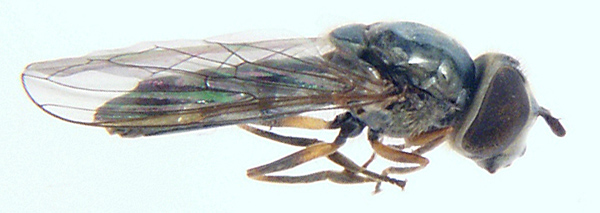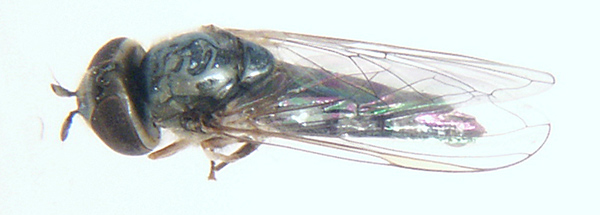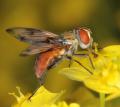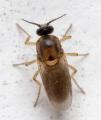Diptera.info :: Family forums :: Syrphidae
|
Platycheirus ambiguus
|
|
| Susan R Walter |
Posted on 20-05-2006 17:15
|
|
Member Location: Touraine du Sud, central France Posts: 1802 Joined: 14.01.06 |
Can someone confirm for me that this is Platycheirus ambiguus, or is it to difficult from a photo? Female, 7mm, from east London cemetery park, 29 April 2006.
Susan R Walter attached the following image:  [61.5Kb] Susan |
| Susan R Walter |
Posted on 20-05-2006 17:16
|
|
Member Location: Touraine du Sud, central France Posts: 1802 Joined: 14.01.06 |
Another view.
Susan R Walter attached the following image:  [54.01Kb] Susan |
| Zeegers |
Posted on 22-05-2006 20:17
|
|
Member Location: Soest, NL Posts: 19086 Joined: 21.07.04 |
I'm not the expert, so I will put my comment in as a question: Why not albimanus ? the female of ambiguus has no spots on the abdomen, but the abdomen nearly uniformely greyish. I seem to see ordinary spots, but you can see better for yourself. Theo Zeegers |
|
|
|
| Susan R Walter |
Posted on 23-05-2006 09:06
|
|
Member Location: Touraine du Sud, central France Posts: 1802 Joined: 14.01.06 |
Theo I thought it might be P ambiguus because it does seem to me to have silver bands rather than spots. I keyed it through Stubbs, and it seems clearly different to one I have identified as P albimanus from the same day and site. It is a smaller, finer fly than my P albimanus. I believe I am familiar with P albimanus as they appear to be one of the species I got in my garden regularly when I first started getting interested in flies a few years ago, but I am not sure I have ever seen P ambiguus before - my record keeping has been a bit haphazard over the years, and I am never overly confident of my ID skills. I know it does not come out well in the photo, and that I should soften her up and pin her properly so you can see the diagnostic features. However, my husband has an aversion to sharing the house with small creatures with pins sticking out of them, and I am so out of practice that I just don't do it anymore. (He can just about cope with flies in tubes in the fridge waiting to be identified and photographed. Indeed, until very recently, he kindly did all my photography for me - but he's bored with flies now - too many little grey muscidanthos, not enough huge colourful asilids.) BTW Paul I am very sorry, but I see that I have carelessly put several Syrphid queries into the Diptera Adult stream. If you can bear it, could you move them? Susan |
| Zeegers |
Posted on 23-05-2006 16:43
|
|
Member Location: Soest, NL Posts: 19086 Joined: 21.07.04 |
Well Susan, You might be right. Just be sure to compare females with females. You wouldn't be the first to ID a female albimanus as ambiguus (indeed, differrent from male albimanus). And ambiguus is pretty rare, so I would be surprised if you have seen it more often. Theo |
|
|
|
| Susan R Walter |
Posted on 23-05-2006 21:22
|
|
Member Location: Touraine du Sud, central France Posts: 1802 Joined: 14.01.06 |
OK - I've been been back to the books and the specimens and I can put up a fight for P ambiguus Luckily I caught a female P albimanus at the same time and could compare. There is a very clear size difference, but some similarities, for instance, the facial profile is very similar, as is the dusting pattern on the face. With the naked eye, the small specimen appears to have bands and the big one spots, but just to make sure I looked at the small one in the manner suggested by Stubbs ie viewed from behind, and it still looked like bands (using illuminated 10x magnification). The one other real difference that I noted was the colour of the hind femora. My P albimanus has entirely black hind femora, whereas the P ambiguus has orange basal half and black apical half. Unfortunately, Stubbs doesn't say anything about leg colour, so I don't know how significant this is. Ball and Morris in the Provisional Atlas of British Hoverflies say that 'although a very local species, it can be abundant in suitable localities.' The map shows a cluster of records around Greater London and surrounds, and according to Stubbs the most likely time to see it is late April. I can discount P discimanus because the antennae have orange patches on the underside of the third segment. I feel I can discount P sticticus because the abdomenal segments did not strike me as square or elongate. Susan |
| Jump to Forum: |













